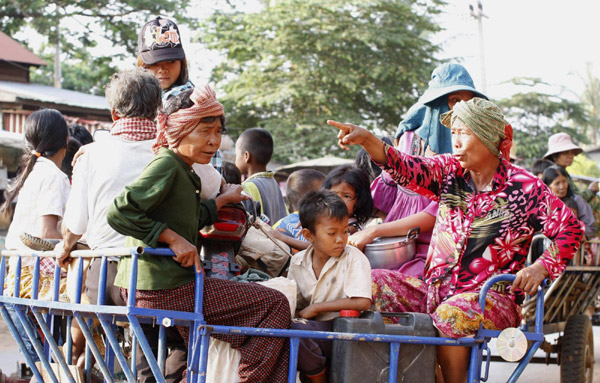Global General
Thai-Cambodia border clash kills 8
(Agencies)
Updated: 2011-04-23 13:00
 |
Large Medium Small |
|
 Displaced Cambodians are evacuated from the Thai-Cambodia border area at Oddar Meanchey province, 20 km (12 miles) from Ta Moan, April 23, 2011. [Photo/Agencies]
|
BANGKOK - Fresh fighting between Thai and Cambodian troops on Saturday killed at last one Thai soldier, raising the number of dead on both sides to eight in two days in the worst bloodshed since the United Nations called for a ceasefire in February.
|
||||
Thai army Lieutenant-General Thawatchai Samutsakorn said one Thai soldier had been killed. At least 13 others were wounded, according to the Phnom Dongrak hospital in Thailand's Surin province. At least 32 soldiers on both sides have been wounded since Friday.
The Cambodia Defense Ministry condemned "in the strongest terms these repeated deliberate acts of aggression" and called on Thailand to permanently cease "hostilities" against Cambodia in order to resolve border problems.
"The apparent goal of Thailand's attacks against Cambodia is to take control over these temples of Cambodia," the Defense Ministry statement said.
Sovereignty over the ancient, stone-walled Hindu temples -- Preah Vihear, Ta Moan and Ta Krabey -- and the land surrounding them in the Dangrek Mountains has been in dispute since the withdrawal of the French from Cambodia in the 1950s.
Ta Moan and Ta Krabey, perched on a 10-meter (32-ft) escarpment about 12 km (seven miles) apart in land mine-riddled jungle, were built in the 12th century during the Khmer empire that once stretched across parts of Thailand and Vietnam before shrinking to present-day Cambodia.
Thailand says the two temples reside in its Surin province according to a 1947 map. Cambodia rejects that and says they are in its Oddar Meanchey province. Before Friday, they jointly patrolled the area largely without incident.
A Thai-Cambodian Joint Commission on Demarcation for Land Boundary has yet to settle the issue despite a 10-year survey of the area. Meanwhile, the temples have fallen into disrepair. In 2008, Thailand accused Cambodia of turning them into an army base.
ASEAN CHAIR URGES RESTRAINT
Cambodian officials have not commented on recent casualties but local journalists monitoring army radio in a town near the fighting told Reuters at least one Cambodian soldier had been killed and two were wounded.
The latest clash began before dawn west of Ta Krabey and lasted several hours. By afternoon, heavy shelling had stopped but small-arms fire could be heard, a day after clashes in the area killed four Thai and three Cambodian soldiers.
Both sides blame each other for starting the fighting, the most severe since three Thais and eight Cambodians were killed and dozens of people wounded over February 4-7 in the bloodiest border clashes in nearly two decades.
As part of a ceasefire deal, Thailand and Cambodia agreed on February 22 to allow unarmed military observers from Indonesia to be posted along their border.
But that arrangement -- brokered at a meeting of the Association for South East Asian Nations (ASEAN) in Jakarta at the urging of the United Nations -- has yet to be put in place. Thailand said international observers were not required, insisting the neighbors should resolve the issue bilaterally.
Thai Foreign Minister Kasit Piromya said on Friday the international community had no place in the matter, responding to a letter from Cambodia addressed to ASEAN stating Thailand had staged "a large-scale attack."
Thailand and Cambodia have been locked in a standoff since July 2008, when Preah Vihear was granted UNESCO World Heritage status, which Thailand opposed on the grounds that the land around the temple had never been demarcated.
An international court awarded the temple to Cambodia 49 years ago but both countries lay claim to a 4.6 sq km (1.8 sq mile) patch of land around it.
Indonesia, the current chair of ASEAN, has urged restraint.
The reasons behind this year's skirmishes are murky and both sides typically blame each other, but the dispute has become a bone of contention in Thailand's fractious domestic politics.
Some analysts say some hawkish Thai generals and their ultra-nationalist allies, who wear the Thai king's color of yellow at protests, may be trying to create a pretext to stage a coup and cancel elections expected in June or July.
Others say it may be a breakdown in communication at a time of strained relations between the neighbors and unease after a rumor of an imminent military coup swirled in Thailand on Thursday. The army has dismissed the rumors as baseless.
Thailand and Cambodia are both members of ASEAN which plans to form a European-style single market by 2015.
| 分享按钮 |

